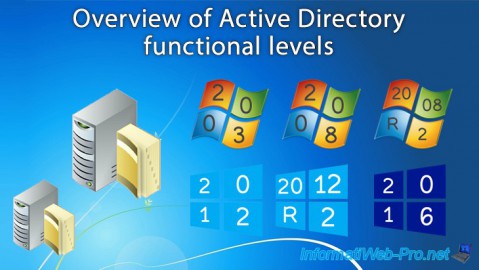Configure and add administrative templates (admx / adm) in an Active Directory infrastructure on Windows Server 2016
- Windows Server
- 15 October 2021 at 11:46 UTC
-

- 2/2
5. Add an administrative template in ADMX format
To add an administrative template in ADMX format, download it from the publisher's site and follow the procedure provided by the publisher.
In our case, we are going to add the ADMX administrative template for Microsoft Office 2013 in 64-bit.

In the case of this administrative template provided by Microsoft, you must agree to the license terms.

Then, select a folder where the different files will be extracted (including ADMX and ADML files, but not only).
In our case, we extracted the files into a new folder which we named "admx office 2013".

Wait while the files are extracted.

Click OK.

As you can see, among the extracted folders and files, you will find a "admx" folder.

In this "admx" folder, we find the normal tree structure of administrative templates in ".admx" format.
As you can see, there are for example administrative templates for :
- Microsoft Access 2013 : access15.admx
- Microsoft Excel 2013 : excel15.admx
- Microsoft Outlook 2013 : outlk15.admx
- and more

In the "xx-xx" folders, you will find translations of the various policies settings available in many languages.
In your case, it's the "en-us" folder that interest you.

You therefore copy all the ".admx" files and the "en-us" folder which corresponds to your language.

And you paste them in your "PolicyDefinitions" folder.
Warning : if you have created the central store as explained previously, you must obviously use the "PolicyDefinitions" folder located in : \\[DC name]\[AD domain name]\Policies

Translations have also been added.

If you open the Group Policy Management Editor again (by editing a random GPO), you will see that new administrative templates for Microsoft Office 2013 have appeared in the "Computer Configuration" section.

Among the group policies available for Microsoft Office 2013, you can for example manage volume activation (VL) and manage the installation of updates.

If you open a policy setting, you will see that everything will be written in your language (if this is supported by the installed administrative template).
Which may not be the case for those in ADM format which were not necessarily available in your language.

Note that when you add new administrative templates, these administrative templates may also appear in the User Configuration if policy settings are available for the user.

6. Add an administrative template in ADM format
If you need to use old administrative templates that are in ADM format, here's how.
As before, you download them from the publisher's site and follow the necessary steps to obtain the desired ".adm" files.
For this example, we downloaded an old administrative template in ADM format for Microsoft App-V 4.5/4.6.

The installation is simple, click Next at each step.

And we end up with the ".adm" files we need.
In this case, we have 2 files :
- AppVirt.adm : this administrative template is used to configure 32-bit clients
- AppVirt64.adm : this administrative template is used to configure 64-bit clients

To import these old administrative templates in ".adm" format, you must right-click on "Administrative Templates ..." and click on : Add/Remove Templates.

In the "Add/Remove Templates" window that appears, click the "Add" button.

Select the desired ".adm" file.
Note that it's not possible to import ".admx" files here. It's for this reason that we had copied them directly via the file explorer.

The desired administration template in ".adm" format appears in the list.

Once at least one administrative template in ".adm" format has been added, a "Classic Administrative Templates (ADM)" subfolder will appear in the "Administrative Templates: Policy definitions (ADMX files)".
In this sub-folder, you will find your administrative template(s) imported from the "ADM" format.

However, as explained above, the main drawback of this old format is that it was very often available in one language.
So, you end up with a console in your language and policy settings in another language for these old administrative models.

Share this tutorial
To see also
-

Windows Server 4/16/2021
Windows Server - AD DS - How Active Directory replication works
-

Windows Server 4/30/2021
Windows Server - AD DS - Overview of Active Directory functional levels
-

Windows Server 4/3/2021
Windows Server - AD DS - The basics of Active Directory
-

Windows Server 5/21/2021
WS 2016 - AD DS - Add a domain controller to an existing AD domain

No comment